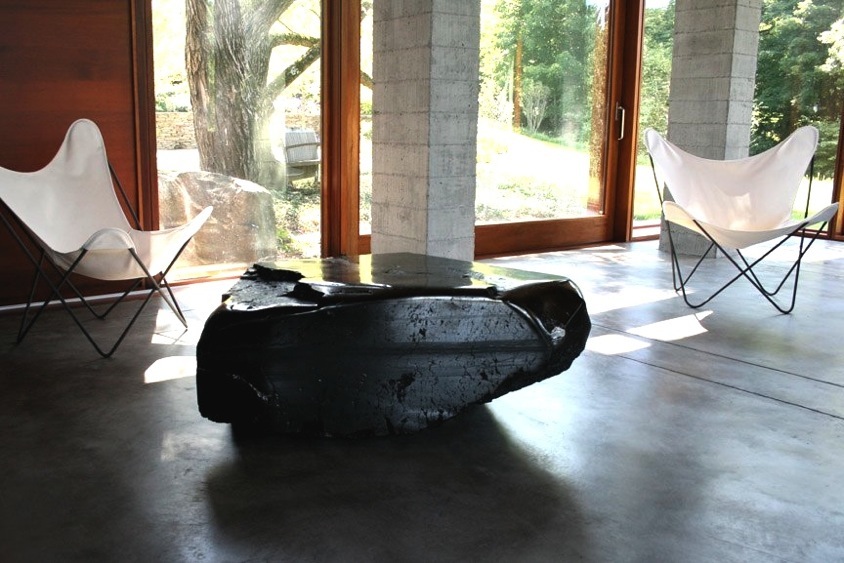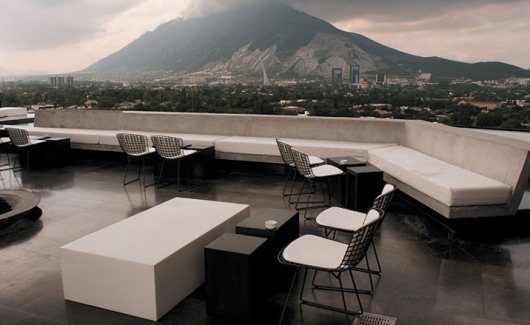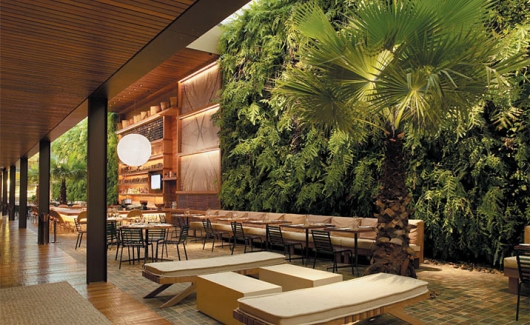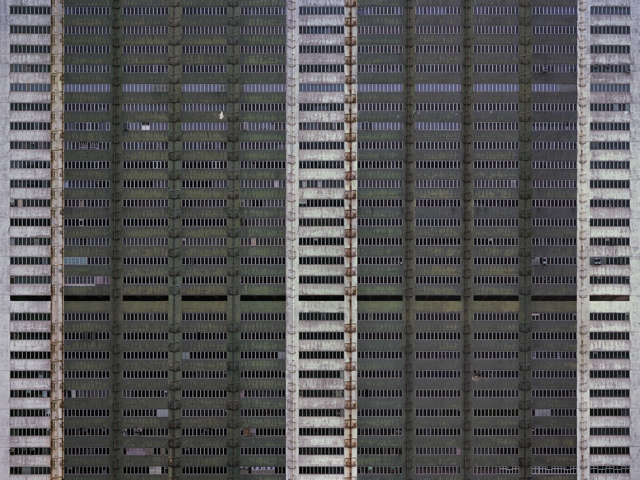we checked this past weekend some nice packaging:
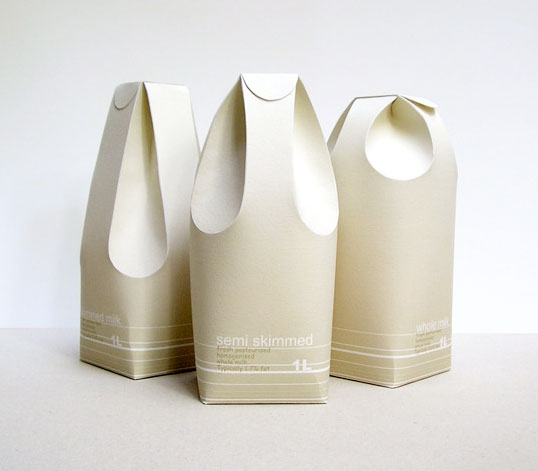
Designed by Raw Edges | Country: United Kingdom
An excellent example of structural package design applied in a functional and communicative way.
“These three different milk cartons distinguish between the rates of fat in the milk by using form rather than colour. The form of the milk cartons reflects in a way on the milk’s texture and smoothness. The two back folds are used as the carton’s handle, while the two in the front function as the spout.”
---
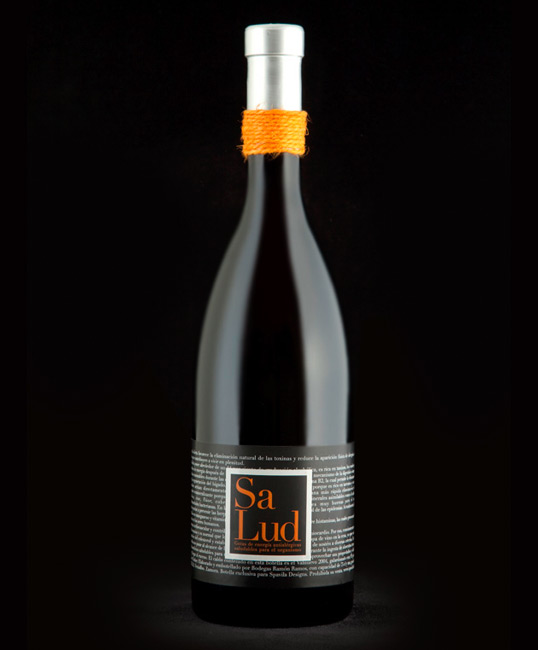
Designed by Spavilla Designs | Country: Spain
“Health is the promotional wine from Spavilla Designs. An elaborate packaging for this limited edition, which the prestigious Robert Parker has given a rating of 93 points.”
---
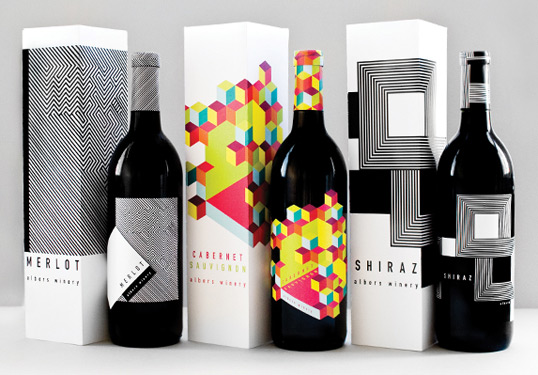
Designed by Meeta Panesar | Country: United States
“The design is inspired by the colors and designs of Joseph Albers and the Op Art movement. The usage of the rectangular elements reflects Alber’s “Homage to the Square,” a series of paintings begun in 1949.”
---
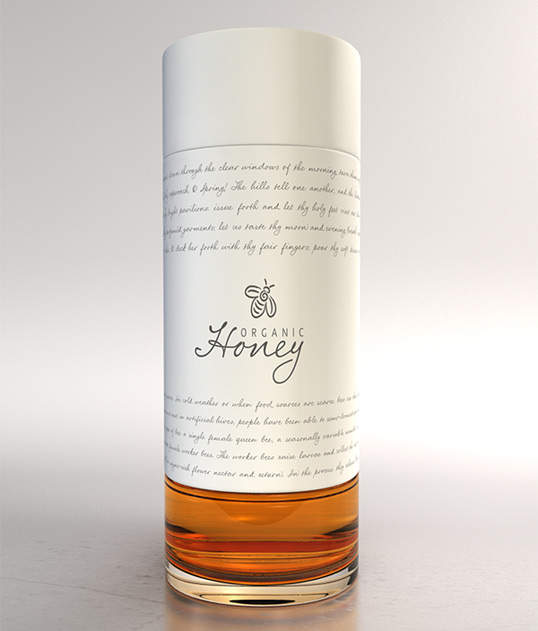
Designed by Marcel Buerkle | Country: South Africa
This elegant, copy driven packaging concept is the work of South African based designer Marcel Buerkle. The shape and cleanliness of the design almost gives it a bit of a high end perfume look and feel.
---
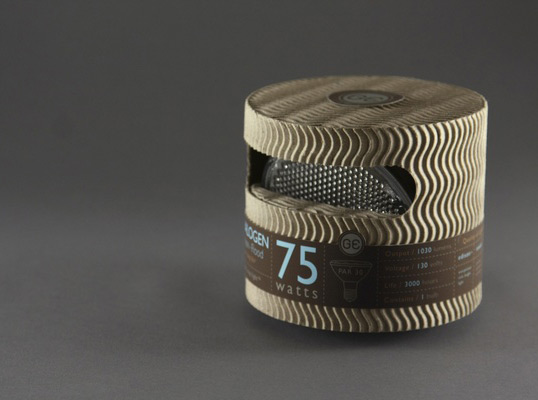
Designed by Mongkol Praneenit | Country: United States
“This is a redesigned for General Electric high-end light bulbs. The package is designed with recycled material to promote sustainability. Information is cleanly organized into a label system to reduce printing over the whole package.”
---
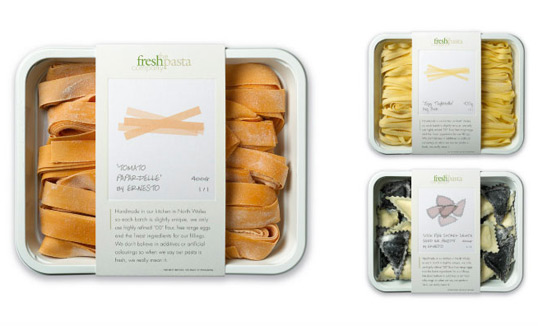
Designed by P&W | Country: United Kingdom
“The brief: Packaging for a company producing high end, handmade fresh pasta. The solution: We created fine art style prints of the pasta shapes, each one signed by ‘the artist’. The result: Improved sales and increased listings with no advertising support.”
---
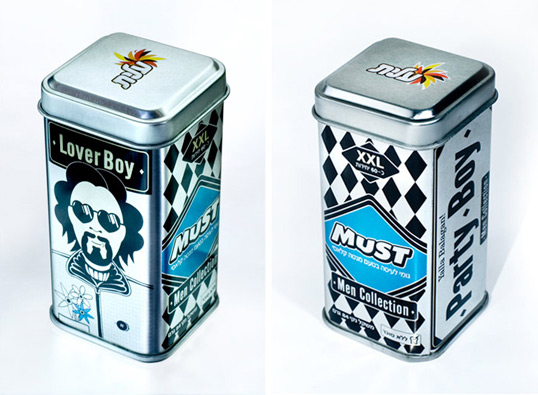
Designed by Oi Design Studio | Country: Israel
“The Brief: When The Strauss group fixed the intention of launching a series of consumer products aimed at men, they requested that we devise a marketing concept for the new products of ‘MUST’, starting with the packaging that will project a strong difference from competitors products on the shelf.
The Solution: ‘Must - Men Collection’ - chewing gum for men only. We chose a collection of illustrated Presenters: male types that we all know and admire - go-getters, women love these men and boys copy them. We put them on metal containers which are especially masculine and gave to each presenter a stage for his male life philosophies.”
---
all via lovelypackage.com
Sunday, January 31, 2010
weekend visual fix
Etiquetas:
design,
graphic art,
Graphic Design
Friday, January 29, 2010
Coal Furniture
For the past decade, Jim Zivic’s medium has been coal, which he sculptures, hones and polishes into massive tables for clients like Lou Reed and Salma Hayek. “It’s a little romance with the muck,” the designer says of the anthracite chunks, which he buys 14 tons at a time from a mine in Pennsylvania and stores in the backyard of his upstate New York house.
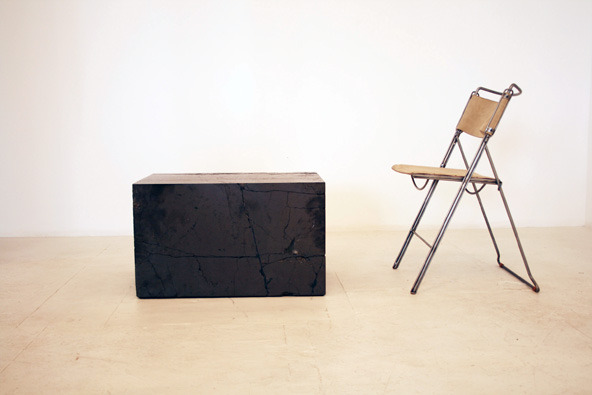
The coal’s earthiness appeals to Zivic, but the irony of his situation doesn’t escape him. “The same stuff my neighbors are burning for heat, Ralph is selling for thousands of dollars,” he says, referring to Ralph Pucci, the owner of Ralph Pucci International, the company that is known for its fashion mannequins and its furniture by cutting-edge designers.
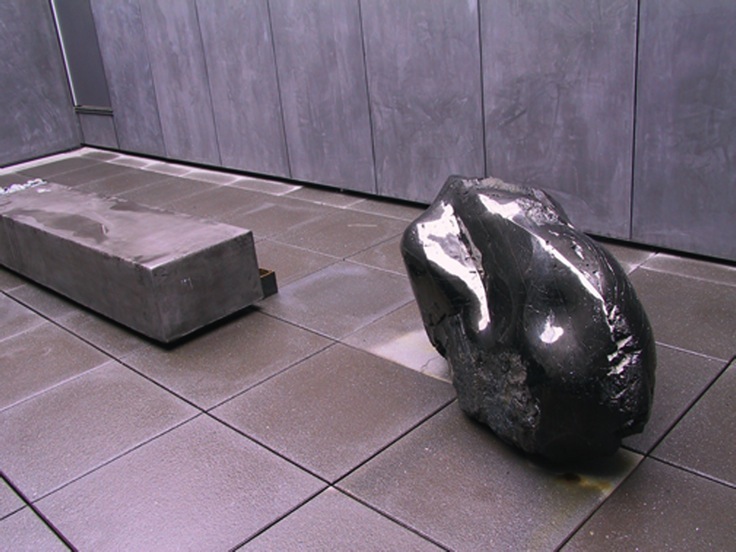
Jim Zivic's Coal Tables are carved from anthracite coal (100% pure carbon, not to be confused with charcoal). Each piece of raw coal is unique in shape, and the designer allows this to dictate the final silhouette of the table. The piece maybe shaped organically, or cut into more geometric linear lines.
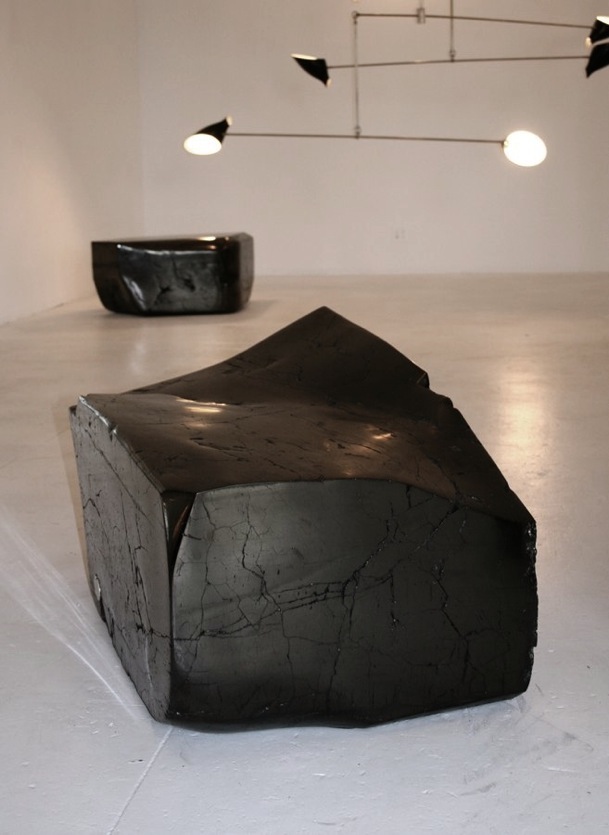

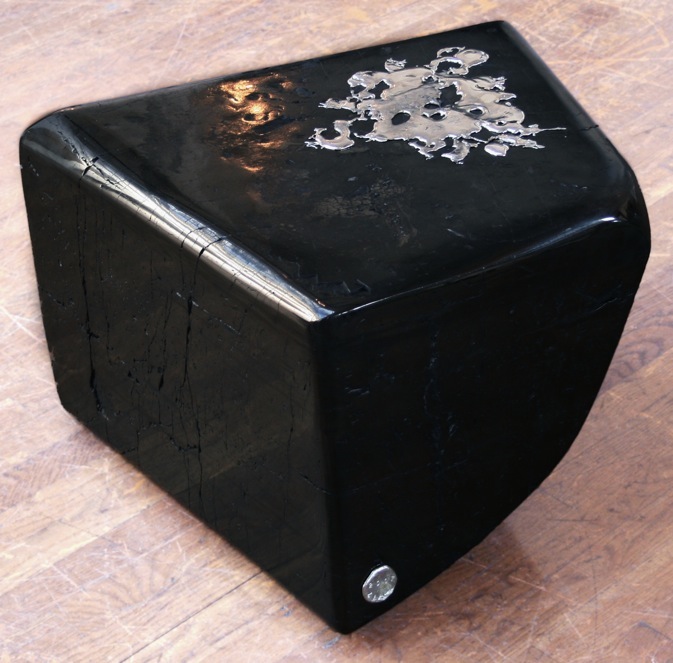
Etiquetas:
furniture design,
interior design
Sunday, January 24, 2010
Dot. Dot. Polka dot.

Polka dots are back in 'fashion'. Not that they were ever out. While polka dots are ancient, they first became common on clothing in the late nineteenth century in Britain. At the same time polka music was extremely popular and the name was also applied to the pattern, despite no real connection between them. The polka dot also appears in popular music. Remember "Itsy Bitsy Teenie Weenie Yellow Polka Dot Bikini" by Brian Hyland? Before that however, "Polka Dots and Moonbeams" was Frank Sinatra's first hit recorded with the Tommy Dorsey Orchestra, published in 1940.
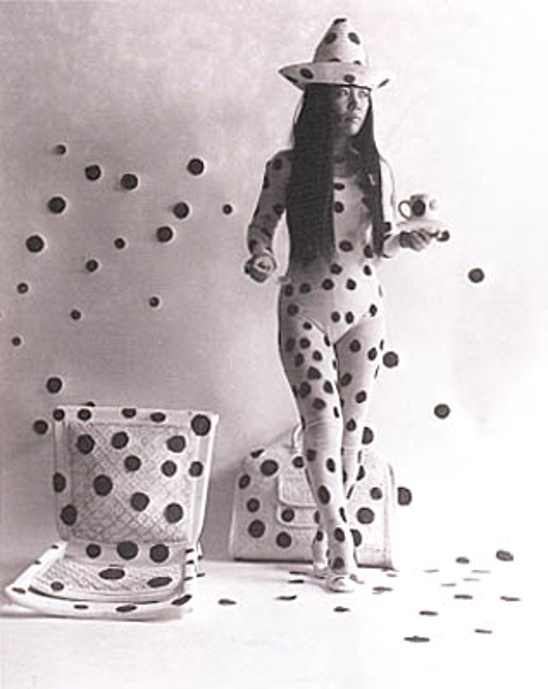
Polka dots have been also the 'thing' that marked the life and work by Yayoi Kusama, japanese avantgarde artist that suffered since childhood from hallucinations and started to cover surfaces with the polka dots. There was a time when she was as well-known as Andy Warhol among admirers of Pop Art. Acknowledged as a progenitor of Minimalism, Kusama made headlines for street performances in which she painted polka dots on nude men and women. But Kusama was largely forgotten by the art world after she returned to Japan in 1973, suffering from obsessive-compulsive disorder. She was committed to a mental institution, where she remains to this day.


Kusama’s neglect by art history has been redressed in a traveling retrospective of her seminal 1960s work. When the retrospective was on view in New York’s Museum of Modern Art, shock waves of recognition went through the art world. Lately, her work has been traveling around the world and you can see her work here: Matsumoto City Museum of Art, Nagano, Japan; CITY GALLERY WELLINGTON, New Zealand; Padiglione d'Arte Contemporanea, Milan; Fairchild Tropical Botanic Garden, Miami; and The National Museum of Art, Osaka.



She also collaborated with Japanese mobile provider iida and created a limited art edition mobile phone.

Etiquetas:
art
Monday, January 18, 2010
First Spring; a movie by Prada + Yang Fudong
Inspired by the Chinese adage that "the whole year's work depends on a good start in spring", this bold and beautiful film (9,17 mins) represents an exciting new direction for Prada's visual communications at the start of this decade.
Featuring young men gathered in Shanghai, dressed in Prada menswear, the black and white film portrays a timeless, dreamlike realm where anything is possible.
"First Spring" is Prada's latest collaboration with pioneering Chinese artist Yang Fudong.
Picture in the movie is subtle and sublime, quiet but meaningful:
Etiquetas:
art,
Fashion Design,
movie
Saturday, January 16, 2010
Wallpaper* Design Awards 2010
Wallpaper* just published the winners of their 2010 Design Awards. Entries come from every possible part of the design field, from architecture to fashion design to industrial design, and were awarded in 66 respective categories. A panel of judges, including icons like architect Steven Holl, fashion designer John Galliano, and interior designer Kelly Wearstler, then picked the winners for eleven key awards.
In the category “Best New Private House”, Marcio Kogan’s Paraty House in Costa Verde, Brazil was awarded as winner, and “Best New Public Building” is Koncerthuset in Copenhagen, Denmark by Atelier Jean Nouvel, as also in the Best New Hotel category the award was for Habita MTY by Joseph Dirand and Landa Arquitectos (shown above).
“Best City” this year is - surprise, surprise! - New York whose High Line project was also awarded “Best Life-Enhancer of the Year”.
Here’s a selection of lucky 2010 Design Awards winners (for the complete list of winners please go to Wallpaper.com):
Best City: New York (Video: “City short: New York” by David Usui)
Life-enhancer of the year: The High Line, by Friends of the High Line, James Corner Field Operations and Diller Scofido + Renfro
Best new private house: Paraty House, Costa Verde, Brazil, by Marcio Kogan
Best new restaurant: Kaa, Sao Paulo, Brazil, by Studio Arthur Casas
as seen on BUSTLER
Etiquetas:
architecture,
design
Wednesday, January 13, 2010
Cosa Nostra: Juergen and Missoni
The fashion buzz of today seems to be around the new campaign for Missoni, photographed by Juergen Teller. Opposite to expectations (by some), Missonis have kept this one for the family. Feels as if we had been invited to an Italian home with all the cheese, pasta & vino that comes with it. And we like it.
The ads were shot at the family home in Sumirago, Italy, near the company’s headquarters and feature three generations of Missonis mugging for the camera. Not that it was hard to coax any of them to say “formaggio.” “For us home and factory have always been very close,” explains the label’s designer Angela Missoni. “It just felt like the right moment to propose something real.” And an even better time to cut back on modeling fees. (via T Magazine blog)
The ads were shot at the family home in Sumirago, Italy, near the company’s headquarters and feature three generations of Missonis mugging for the camera. Not that it was hard to coax any of them to say “formaggio.” “For us home and factory have always been very close,” explains the label’s designer Angela Missoni. “It just felt like the right moment to propose something real.” And an even better time to cut back on modeling fees. (via T Magazine blog)
Etiquetas:
fashion,
fashion photography,
photography
Monday, January 11, 2010
The Future of Reading: Printed Media (part 2)
At the end of December we started a conversation about the future of reading. Yes, reading is going digital, “most def”: on Christmas day Amazon for the first time sold more e-books than printed ones. With abundance of e-readers as Kindle, Sony Reader, hardly awaited iTablet and other exciting new reading devices, many of them presented at this year’s Consumer Electronics Show (CES) in Vegas, the future of reading is definitely changing.
But what’s in it for printed media?
While I am a big technology fan, when reading, I still love to hold the magazine or book in my hands, flip through it, touch the paper, see the brightness of colors, smell the fresh print, admire the cover…
_Superyacht, L.E. book by Swedish designer Henrik Persson of Become.
Umair Haque in his Harvard Business Review ideacast "Can Good Journalism also be Profitable?" talks about the future of journalism and what it would need to be (remain) profitable (again). He talks about “turning soda into wine”, thus giving journalism (back) a substance and credibility which will make it stand out of other written word / information found on-line. Some of the things Umair mentions are that 1) publishers should focus on people, not product (media). They’ve changed formats, sizes, design, prices, … What they should try is focus on people, find ways to connect journalists and readers, so they could connect, communicate and see what really matters. Social media here helps a lot (check out how Nicholas D. Kristof of NYTimes is doing it).
The second thing Umair states as a means to reach the goal, is for media to focus on outcomes, not incomes (although 20th century might have had it the other way around) . This (to me) seems logical, although many media publishers don’t seem to get it: if I as a reader feel I am better informed, educated, more engaged in the content, if I get better info from the newspaper or a magazine, I will buy another issue, have confidence in what they ‘preach’, trust their advertisers more,… which at the end means income…
Content is important. But, design matters as well.
Innovative approaches to it, collectibles, limited editions, subtle design details, thoughtful and engaging process of wrapping the content into an outlet a reader would pick up and hopefully even save and behold as a precious book.
The other day I got to know a story behind McSweeney’s, got excited about what they do and how they do it, and wanted to share it with you. “At McSweeney’s – where writers design books, construction workers edit them, and people seemingly pursue projects willy-nilly – the way a reader experiences a book on the outside is taken as seriously as the way they experience it on the inside.
Staff and collaborators dream up elaborate and whimsical packaging approaches that seduce before you even crack the cover. Issue 17 of McSweeney’s Quarterly Concern looked like a pile of mail, Issue 23 boasted an elegant “Z binding” that opened from both sides, and Issue 28 saw eight mini-books (containing one fable apiece) banded together with interlocking cover illustrations. Supported by McSweeney’s unique creative process, in which the same set of people typically see a book through from editing to design to publishing, the physical look of the books is always deeply connected to the text inside. And yet, the people responsible for them are “not really designers.” So what gives?
_McSweeney's Quarterly Concern, San Francisco Panorama
According to Horowitz, who has done time in nearly every position within the company, what is seen on the shiny surface of things like McSweeney’s Quarterly Concern is largely a result of dreaming up things they’re not qualified to do, and don’t have the manpower for. What’s more, this no-holds-barred mentality, driven by a bootstrappy enthusiasm and bountiful, if not officially trained, creative talent, has earned them recognition by the National Book Critics Circle Awards, as well as design awards including the AIGA 50 Books Award, AIGA 365 Illustration Award, and the Print Design Regional Award.
While traditional publishers have more resources, McSweeney’s small size – just 10 full-time employees – and perpetual willingness to take risk, allows them to be more nimble and infinitely more innovative. Take, for instance, the latest issue of the Quarterly Concern, the San Francisco Panorama, which brazenly took the form of a Sunday paper. Conceived as a form of rebellion against the news industry’s rumored demise, the gorgeous, 320-page issue sold out in moments, and garnered press coverage all the way from the Bay to the New York Times." One of McSweeney's mantras is: Never having done something before is a bad reason not to do it.
And what matters to you? Content, design, both? Why? How do you read? Would love to hear your opinion!
Etiquetas:
communications,
Graphic Design
Thursday, January 7, 2010
ARCHITECTURE OF DENSITY
Today while having a beer after closing the studio, i was watching Paul McCartney’s “Band on the Run” video, and i started to realize how much cities have grown and changed in the last 30 to 40 years. Those early images of Singapore or Sidney that are shown in the video made me mentally juxtapose them to the photography of Michael Wolf, and here we present you his work. Wolf is a photographer born in Munich, Germany. He grew up in the USA and studied at UC Berkley and at the University of Essen in Germany.
Wolf views ordinary things in extraordinary ways. Culturally astute, Wolf’s artistic inspiration comes from the local culture in which he immerses himself. Michael Wolf has been fascinated by China’s complex urban dynamics since moving to Asia as a contract photographer in 1995 and his photography focuses on the idiosyncrasies of the Asian way of life. Insightful and absorbing, for example, his book “Hong Kong, The Front Door/The Back Door” deals with the SAR’s cultural identity through depictions of the city’s architecture.
“I love the visual chaos of China. It is a photographers dream,” says the photographer. Wolf’s poignant portrayals of the lives and living conditions of his cultural environment are subjective and personal and have earned him international acclaim. As described by Art Critic Kenneth Baker, “By their formal intelligence and acuity of observation, Wolf’s Hong Kong pictures easily earn the status of art works.”
“…Buildings that begin as monoliths are slowly humanized by their inhabitants; architecture becomes a framework upon which people can hang their personal personalities…” -Douglas Young about the work by Michael Wolf
Wolf stands by his motto: “If you are a vision and real conviction, you will find success.”
Etiquetas:
architecture,
arts,
inspiration,
photography
Subscribe to:
Comments (Atom)

